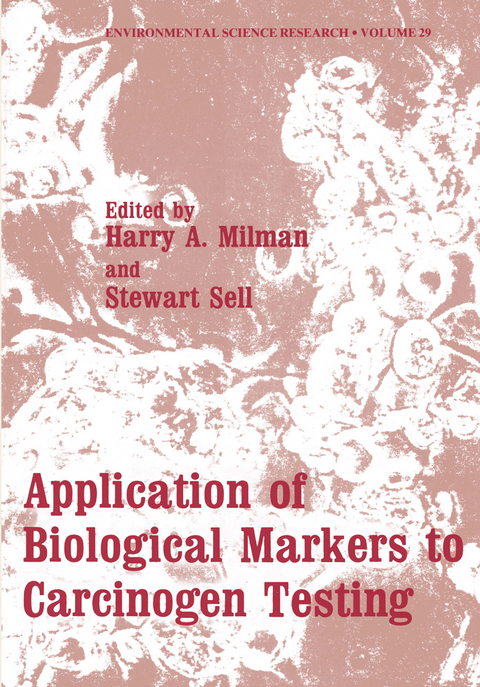
Application of Biological Markers to Carcinogen Testing
Springer-Verlag New York Inc.
978-1-4613-3792-8 (ISBN)
Welcoming Remarks.- An Overview of Current Research Efforts on the Application of Biological Markers to Carcinogen Testing.- In Vivo Tests.- Chairman’s Overview on In Vivo Tests.- The Occurrence of Neoplasms in Long-Term In Vivo Studies.- Markers of Liver Neoplasia — Real or Fictional?.- Early Morphologic Markers of Carcinogenicity in Rat Pancreas.- Rodent and Human Models for the Analysis of Intestinal Tumor Development.- Effect of Diet on Intestinal Tumor Production.- Tumor Antigens as Markers for Carcinogens.- In Vitro Tests.- Chairmen’s Overview on In Vitro Tests.- Biochemistry and Biology of 2-Acetyl-Aminofluorene in Primary Cultures of Adult Rat Hepatocytes.- Relating In Vitro Assays of Carcinogen-Induced Genotoxicity to Transformation of Diploid Human Fibroblasts.- Evaluation of Chronic Rodent Bioassays and Ames Assay Tests as Accurate Models for Predicting Human Carcinogens.- Indices for Identification of Genotoxic and Epigenetic Carcinogens in Cell Culture.- Enzymes.- Chairmen’s Overview on Enzyme Markers.- Aryl Hydrocarbon Hydroxylase Activity “of Mice and Humans”.- Gamma-Glutamyl Transpeptidase Expression in Neoplasia and Development.- Ornithine Decarboxylase: Alterations in Carcinogenesis.- Human Tumors: Enzyme Activities and Isozyme Profiles.- Enzyme and Isoenzyme Patterns as Potential Markers of Neoplasia in Breast Tissue.- Oncofetal Antigens and Hormones.- Chairmen’s Overview on Oncodevelopmental Markers.- Alphafetoprotein as a Marker for Early Events and Carcinoma Development During Chemical Hepatocarcinogenesis.- Human Chorionic Gonadotropin and its Subunits as Tumor Markers.- Prostaglandins and Cancer.- Monoclonal Antibodies.- Chairmen’s Overview on the Use of Immunoanalytical Method for the Characterization and Quantification of DNAComponents Structurally Modified by Carcinogens and Mutagens.- Immunological Approaches for the Detection of DNA Modified by Environmental Agents.- Detection of Thymine Dimers in DNA with Monoclonal Antibodies.- Immunological Studies on the Influence of Chromatin Structure on the Binding of a Chemical Carcinogen to the Genome.- High-Affinity Monoclonal Antibodies Specifically Directed Against DNA Components Structurally Modified by Alkylating N-Nitroso Compounds.- Carcinogen-Induced Modification in DNA.- Chairmen’s Overview on Carcinogen-Induced Modification in DNA.- Use of Repair-Deficient Mammalian Cells for the Identification of Carcinogens.- Thymine Modifications in DNA as Markers of Radiation Exposure.- Aberrant Methylation of DNA as an Effect of Cytotoxic Agents.- Identification of Carcinogen-DNA Adducts by Immunoassays.- Viruses.- Chairman’s Overview on Integration and Expression of the Polyoma Virus Oncogenes in Transformed Cells.- Activation of Cellular onc (c-onc) Genes: A Common Pathway for Oncogenesis.- Hepatitis B Virus as an Environmental Carcinogen.- Roundtable Discussion.- Research Needs on the Use of Tumor Markers in the Identification of Chemical Carcinogens.- Posters.- The Polypeptides of the Cytosol of Hepatocyte Nodules May Exhibit a Unique Electrophoretic Pattern.- Rat Alloantigens as Cellular Markers for Hepatocytes in Genotypic Mosaic Livers During Chemically Induced Hepatocarcinogenesis.- Metabolic Considerations in the Toxicity and Mutagenicity of the Nitronaphthalenes.- Detection and Identification of Common Oncofetal Antigens on In Vitro Transformed Mouse Fibroblasts.- Inhibition of Metabolic Cooperation Between Cultured Mammalian Cells by Selected Tumor Promoters, Chemical Carcinogens, and Other Compounds.- A Rapid In Vitro Assay forDetecting Phorbol Ester-like Tumor Promoters.- Induction of Endogenous Murine Retrovirus by Chemical Carcinogens.- In Utero Induction of Sister Chromatid Exchanges to Detect Transplacental Carcinogens.- Evaluation of Known Genotoxic Agents and ?9 -Tetrahydrocannabinol for SCE Induction by the Intraperitoneal 5-Bromo-2’-Deoxyuridine Infusion Technique for Sister Chromatid Exchange Visualization.- Effect of 2,3-Oxide-3,3,3-Trichloropropane on BaP Metabolism in Mullet.- The Effect of Dimethylbenzanthracene on the NK Activity of Mice.
| Reihe/Serie | Environmental Science Research ; 29 |
|---|---|
| Zusatzinfo | 516 p. |
| Verlagsort | New York, NY |
| Sprache | englisch |
| Maße | 170 x 244 mm |
| Themenwelt | Sachbuch/Ratgeber ► Natur / Technik ► Garten |
| Naturwissenschaften ► Physik / Astronomie ► Allgemeines / Lexika | |
| ISBN-10 | 1-4613-3792-5 / 1461337925 |
| ISBN-13 | 978-1-4613-3792-8 / 9781461337928 |
| Zustand | Neuware |
| Haben Sie eine Frage zum Produkt? |
aus dem Bereich


